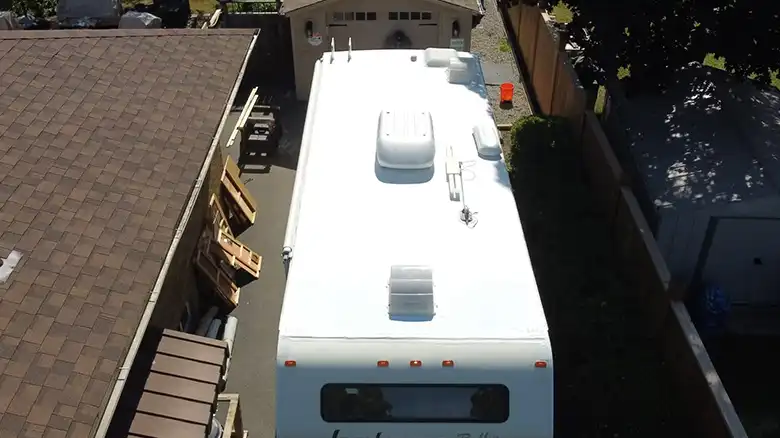Owning an RV is a wonderful way to explore the open road, but like any vehicle, it requires maintenance. One critical aspect of RV maintenance is the roof. Over time, the roof of your RV can deteriorate due to exposure to the elements, and you might find yourself in need of a replacement.
The cost of an RV roof replacement can vary widely, but in this article, I will explore the cheapest way to replace your RV roof. We’ll discuss typical costs, how to reduce them, DIY alternatives, and provide you with valuable tips for achieving the most cost-effective solution.

Typical Costs for RV Roof Replacement
The cost of replacing an RV roof can significantly impact your budget, and it varies depending on several factors. On average, a professional RV roof replacement can cost anywhere from $1,000 to $5,000 or more. Factors influencing the cost include the size and type of your RV, materials used, and labor expenses. Rubber and TPO (Thermoplastic Olefin) roofs are common choices, and they come in various price ranges.
How to Lower the Cost of RV Roof Replacement
Reducing the cost of your RV roof replacement is essential. Here are some tips to help you save money:
DIY Preparations: Save on labor costs by preparing your RV for the replacement yourself. Remove fixtures, vents, and other items from the roof to make the process smoother for the professionals.
Choose Affordable Materials: Opt for cost-effective roofing materials like EPDM (Ethylene Propylene Diene Monomer) rubber, which is durable and reasonably priced.
Shop Around: Get quotes from multiple RV repair shops and compare prices. Look for deals, discounts, and promotions to find the most cost-effective option.
Insurance Coverage: Check if your RV insurance policy covers roof replacement due to damage or wear and tear. This can significantly reduce your out-of-pocket expenses.
DIY Tips and Alternatives to Save on RV Roof Replacement
If you’re handy and looking to save even more money, there are some DIY alternatives and cost-saving ideas to consider:
Liquid Roof Coating: Apply liquid roof coatings to seal minor leaks and extend the life of your existing roof. These coatings are relatively inexpensive and easy to use.
Patching and Repairs: If your roof has minor issues, consider patching and repairs rather than a full replacement. It’s a fraction of the cost and can be a temporary solution.
DIY TPO or EPDM Installation: While not recommended for beginners, if you have roofing experience, you can consider installing a TPO or EPDM roof yourself. Be sure to research thoroughly and follow proper installation guidelines.
Salvage Roofing Materials: Look for salvaged or second-hand roofing materials, which can be significantly cheaper than new ones. Just ensure they are in good condition.
Step-by-Step Guide to Replacing Your RV Roof
For those willing to take on a DIY roof replacement project, here’s a step-by-step guide to help you do it the cheapest way possible:
Assess the Roof: Thoroughly inspect your RV roof to identify any issues. Determine whether a complete replacement is necessary or if repairs can suffice.
Gather Materials: Purchase the required roofing materials, tools, and safety equipment. Make sure you have everything you need before starting the project.
Remove the Old Roof: Carefully remove the old roofing material, taking care not to damage the underlying structure. Dispose of the old material properly.
Prepare the Roof Surface: Clean and repair the roof surface, ensuring it’s free from any debris, and apply appropriate adhesives or sealants as needed.
Install the New Roof: Follow the manufacturer’s guidelines for installing the new roofing material. Take your time to ensure proper alignment and secure adhesion.
Seam and Seal: Pay close attention to seams and edges to prevent water infiltration. Use seam tape and sealant to create watertight connections.
Reattach Fixtures: Reattach fixtures, vents, and any other items removed earlier. Ensure they are properly sealed to prevent leaks.
Final Inspections: After the installation, inspect the roof thoroughly for any imperfections or areas that require additional sealing.
Maintain Regularly: To extend the life of your DIY roof replacement, conduct regular inspections and maintenance to catch issues early and prevent major problems.
Common Questions About RV Roof Replacement
Can I patch my RV roof instead of replacing it?
Yes, you can patch minor issues on your RV roof. However, for significant damage or extensive wear, a full replacement is recommended for long-term durability.
Are there any warranties for DIY roof replacements?
Warranties vary by manufacturer and may apply to DIY installations if you follow their guidelines. Be sure to check the warranty terms when purchasing materials.
What’s the best season to replace an RV roof?
Ideally, spring or fall when the weather is mild. Extreme temperatures and precipitation can affect the quality of the installation.
Is it safe for a beginner to replace an RV roof themselves?
It’s not recommended for beginners, as it’s a complex task that requires experience and knowledge of roofing techniques.
End Notes
Replacing your RV roof doesn’t have to break the bank. By exploring cost-saving options, and DIY alternatives, and carefully considering your choices, you can achieve the cheapest way to replace your RV roof while maintaining the structural integrity of your beloved vehicle. Whether you choose to hire professionals or embark on a DIY adventure, a well-maintained roof ensures your RV continues to be your ticket to adventure on the open road.


